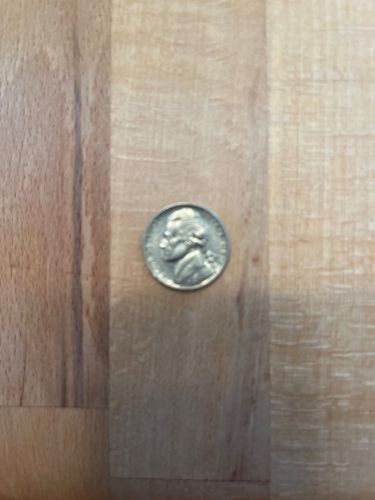Jefferson Nickel
Country of Origin: United States
Year of Issue: Based on the design, it is a Jefferson Nickel issued between 1938 and the present day. Without a visible date on the coin, a specific year cannot be determined. Typically, the date is located on the obverse, below Jefferson's portrait.
Denomination: 5 Cents (Nickel)
Composition: Prior to 1942 and from 1946 onwards, theJefferson Nickel is composed of 75% copper and 25% nickel. During 1942-1945, due to wartime needs, the composition was modified to 35% silver, 56% copper, and 9% manganese (known as 'War Nickels'). Without seeing the reverse and date, the exact composition cannot be definitively stated from this image alone.

Brief Description
The coin features a profile portrait of Thomas Jefferson on the obverse. The reverse typically depicts Jefferson's home, Monticello. In the provided image, only the obverse is clearly visible, showing Jefferson's left-facing portrait, a design that was first introduced in 1938.
Historical Significance
The Jefferson Nickel replaced the Buffalo Nickel in 1938 and has been in continuous production ever since. It was designed by Felix Schlag. The introduction of the Jefferson Nickel marked a shift in US coinage design towards depicting past presidents more frequently. The 'War Nickels' (1942-1945) are historically significant due to their altered silver composition, necessitated by the need to conserve nickel for the war effort during World War II.
Estimated Value
The value of a Jefferson Nickel varies greatly depending on its year, mint mark, condition, and whether it's a regular strike or a 'War Nickel'. Common issues in circulated condition often trade for face value or slightly above (e.g., $0.05 - $0.50). Key dates, varieties, and uncirculated examples can fetch much higher prices (tens to hundreds of dollars). A clear date is needed for a more precise estimate.
Care Instructions
Handle coins by their edges to avoid transferring oils from your skin. Store in inert, archival-safe holders (e.g., Mylar flips, acrylic capsules, or albums designed for coin storage) to protect them from environmental damage and physical abrasion. Avoid cleaning the coin, as this can devalue it significantly. For valuable coins, consider professional grading and encapsulation.
Created At: 2025-09-03T15:31:02.202077